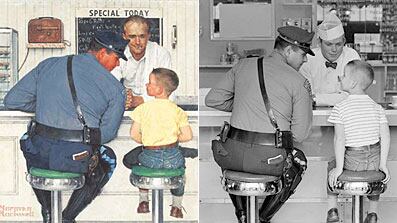Beloved by many people for his idealistic portrayal of the American Dream yet dismissed by scores of critics as a corny illustrator of conservative values, Norman Rockwell may be one of the most misunderstood artists of the last century. During our current times of continuous wars, unrepentant greed, and increased unemployment, his vision of life’s simple pleasures and the communal celebration of everyday activities is all the more welcome. Two dynamic traveling exhibitions, organized by the Norman Rockwell Museum in Stockbridge, Massachusetts, now offer us a chance to re-evaluate the American master and his 65 years of creativity.
Click Image To View Our Gallery Of Norman Rockwell Double Takes

American Chronicles: The Art of Norman Rockwell, which is on view at the Museum of Art Fort Lauderdale through February 7, 2010, features 40 original oil paintings, as well as preliminary sketches, posters, reference photographs, notes, and correspondence from the Norman Rockwell Museum collection. Among the show’s highlights are the 1921 Saturday Evening Post cover painting, No Swimming, which captures three young boys stripping off their clothes while racing toward a forbidden pond to go skinny dipping; 1954 SEP cover painting Girl at Mirror, which depicts a teenage girl casting aside her doll in favor of contemplating her newly made-up appearance, in relation to a magazine starlet, in the mirror; and the 1960 SEP cover canvas Triple Self-Portrait, that ironically shows the aging artist portraying himself in a more upbeat manner.
Outstanding works in American Chronicles from the Look magazine period are the 1964 painting The Problem We All Live With, Rockwell’s civil-rights masterpiece that presents a young black girl in a white dress on her way to attend a newly integrated New Orleans school while being escorted by three U.S. marshals and passing a wall that bears racist graffiti and the mark of a freshly thrown tomato; 1966 canvas The Peace Corps (JFK’s Bold Legacy), which shows President Kennedy at the forefront of an optimistic youth movement; and the 1965 drawings, reference photographs, preliminary sketch, and final canvas for Murder in Mississippi, which illustrates three civil-rights workers being slain by a shadowy mob.
Norman Rockwell: Behind the Camera, on exhibit at the Norman Rockwell Museum, through May 31, 2010, reveals talents of the artist that few people knew existed: namely, his marvelous sense of art direction and photographic eye. Rockwell meticulously staged his pictures. Beginning with sketches of what he wanted to achieve, Rockwell would cast his models, pose them in the way he imagined them in the final image, and have his cameraman make black-and-white photographs, which he then used as studies for his paintings. At times the staged photographs almost match the final picture, while at other moments the photograph represents only one element in a more complex composition. Although Rockwell never considered the photographs as part of his art, recent postmodernist practices allow us to view these works differently today.
Rockwell photographed his Arlington, Vermont, neighbors as though they were telling a juicy story and listening to one for The Gossips, a humorous 1948 painting that was created as a Saturday Evening Post cover. Likewise, he cast a local Stockbridge boy and a neighboring state trooper to play the main parts in The Runaway, a 1958 cover painting that shows a policeman and a fugitive child forming a bond at a diner counter. While the pose of the players remain the same, Rockwell altered the final picture to give it a more homespun feeling. In these, and in other works, such as 1963’s Marriage Counselor, which was never published, the photograph is so detailed and considered that it has an uncanny relationship to the final painting.
“Rockwell was using Photoshop before Photoshop existed,” Charles Desmarais, deputy director for art at the Brooklyn Museum, which will show Norman Rockwell: Behind the Camera in early 2011, said in a telephone interview. “We’re able to see a gesture-by-gesture diary of how he built his pictures and how photography has been used in painting.”
There’s no doubt that Rockwell’s work has influenced contemporary artists—just look at some of John Currin and Eric Fischl’s paintings—and modern-day filmmakers, such as George Lucas and Steven Spielberg, who are both Rockwell collectors. In fact, Telling Stories: Norman Rockwell from the Collections of George Lucas and Steven Spielberg opens at the Smithsonian American Art Museum in July 2010. Meanwhile, another show, Norman Rockwell: American Imagist, organized by the National Museum of American Illustration, is on view at New York's Nassau County Museum of Art through January 3.
These concurrent exhibitions make one wonder why Rockwell is being so wildly embraced by the American public again. Could the renewed interest be based on the respect Rockwell gained from a 2002 Guggenheim Museum show and from the record $15.4 million sale of one of his paintings at a 2006 Sotheby’s auction, or is that too cynical of a response?
Museum of Art Fort Lauderdale Executive Director Irvin Lippman has a better reply, “Norman Rockwell captures a universal humanity that we intuitively understand. He paints real people and he shows real emotions. His work is inspirational. His work is beautiful. He paints about the best within all of us. Rockwell often said he painted ‘life as I would like it to be.’ Rockwell was there before Oprah and his works will continue to have an impact far into the future.”
Plus: Check out Art Beast for galleries, interviews with artists, and photos from the hottest parties.
Paul Laster is the editor of Artkrush.com, a contributing editor at Flavorpill.com and Art Asia Pacific, and a contributing writer at Time Out New York and Art in America.






